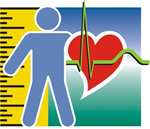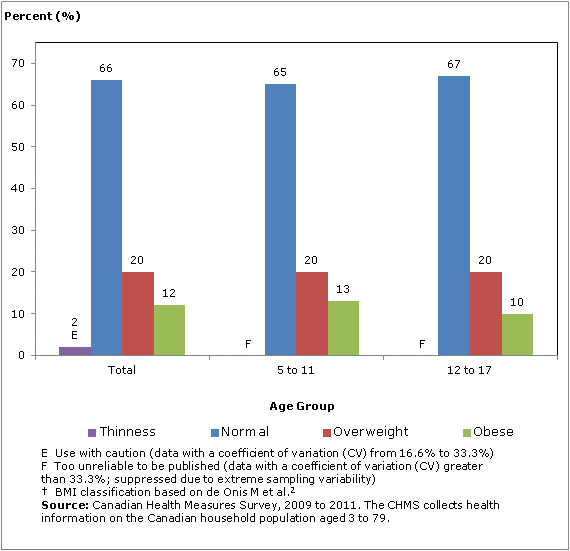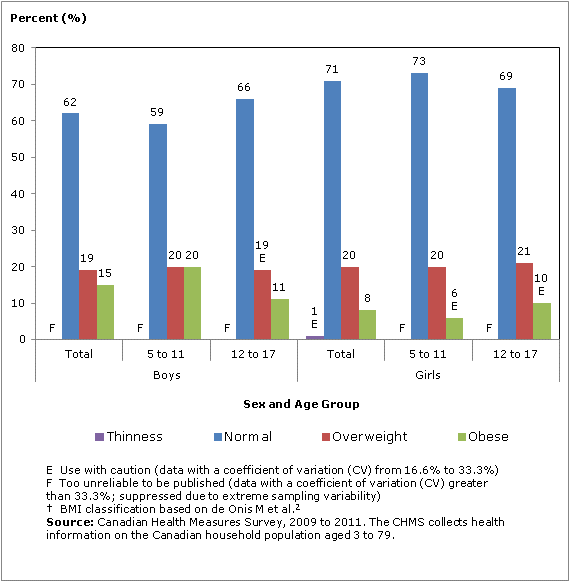Body mass index of Canadian children and youth, 2009 to 2011
Archived Content
Information identified as archived is provided for reference, research or recordkeeping purposes. It is not subject to the Government of Canada Web Standards and has not been altered or updated since it was archived. Please "contact us" to request a format other than those available.

Based on their measured body mass index (BMI), 32% of Canadian children and youth aged 5 to 17 years were overweight or obese in 2009 to 2011.
Excess weight in childhood has been linked to a number of health problems and is a major public health concern. Overweight and obese children have a higher risk of type 2 diabetes, hypertension, poor emotional health and diminished social well-being.Note 1 Overall, 32% of Canadian children aged 5 to 17 had a BMI that classifies them as overweight or obese, while 66% had a normal BMI. When both sexes were combined there was no difference in the likelihood of being overweight or obese between 5 to 11 year olds and 12 to 17 year olds (Chart 1).
Chart 1
Distribution of household population aged 5 to 17, by body mass index norms† and age group, Canada, 2009 to 2011

There was no significant difference in the likelihood of being classified as overweight between sexes, however boys (15%) were significantly more likely to be obese than girls (8%). This appears to be a result of a higher prevalence of obesity in boys aged 5 to 11 (20%) than girls of the same age (6%) as older boys and girls show no significant difference in their rates of obesity. Boys aged 5 to 11 were also significantly more likely to be obese than boys aged 12 to 17 (11%) (Chart 2).
Chart 2
Distribution of household population aged 5 to 17, by body mass index norms† and age group and sex, Canada, 2009 to 2011

About body mass index
Body mass index (BMI) is the ratio of a person's weight in kilograms divided by their height squared in meters (kg/m2). BMI can be interpreted using the following classification table based on the World Health Organization's BMI-for-age Growth References for children and adolescents aged 5 to 17 years.Note 2 This approach is thought to provide more accurate estimates than previous methods used to estimate the prevalence of overweight and obesity in the Canadian population.Note 3
This classification system uses the following cut-offsNote 2:
| Less than or equal to 2 standard deviations below the mean | Thinness |
|---|---|
| Greater than 2 standard deviations below the mean and less than or equal to 1 standard deviation above the mean | Normal weight |
| Greater than 1 standard deviation and less than or equal to 2 standard deviations above the mean | Overweight |
| Greater than 2 standard deviations above the mean | Obesity |
References
- Roberts KC, Shields M, Groh MD, Aziz A, Gilbert JA. Overweight and obesity in children and adolescents: Results from the 2009 to 2011 Canadian Health Measures Survey. Health Reports. 2012;23(3):1-5.
- de Onis M, Onyango AW, Borghi E, Siyam A, Nishida C, Siekmann J. Development of a WHO growth reference for school-aged children and adolescents. Bulletin of the World Health Organization. 2007;85(9):660-7.
- Analyses of cycle 1 of the CHMS, including previous versions of this fact sheet, used different BMI cut-off points. As a result, the estimates are not comparable.
For more information on the Canadian Health Measures Survey, please contact Statistics Canada's National Contact Centre (toll-free 1-800-263-1136; 613-951-8116; infostats@statcan.gc.ca).
- Date modified:
